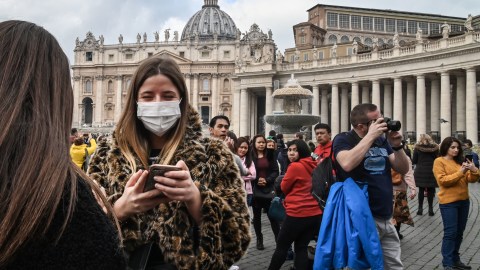Why face masks are going viral

ANDREAS SOLARO/AFP via Getty Images
On the day the first case of the new coronavirus was confirmed in the Philippines, a surreal sight greeted me on the streets of Manila.
Half the people were wearing face masks—from the disposable surgical variety to heavy-duty N95 respirators, which many had purchased just weeks before to protect themselves from ash erupting out of the Taal volcano.
Traveling to Thailand the same week, I was met by a similar scene. All the flight attendants and half the passengers on the plane from Manila to Bangkok had donned masks.
On January 30, the World Health Organization declared that the “unprecedented outbreak” of the novel coronavirus (2019-nCoV) was a global health emergency. As of that date, 7,834 cases of the flu-like disease had been confirmed, and 170 people had died. Nearly 99 percent of cases occurred in China, where the virus first appeared in December before rapidly spreading to 18 other countries.
As a result, masks are selling out around the world, making them one of the most sought-after commodities of our time. A recent cover of The Economist depicts a giant surgical mask wrapped around the Earth.
However, the science on how well masks protect the public is complicated.
Surgical masks are designed to protect health care providers and patients from cross-transmitting large droplets such as blood and saliva. So, they can be somewhat effective when worn by sick people to prevent spreading disease through coughing. But surgical masks provide minimal protection from contracting viruses. And they offer little to no protection from air pollution, since gases such as nitrogen dioxide from vehicles easily pass through, while poor fit and movement allow larger particles to leak in.
Filtering facepiece respirators such as N95s are highly effective in protecting people from inhaling viruses and environmental pollutants. But respirators can make it very difficult to breathe, and they’re only effective if worn properly.
Health agencies stress that there is no need to wear face masks in most circumstances. This advice has not stopped people from hoarding face masks.
People’s motivation for wearing these masks goes far beyond simple considerations of medical efficacy. Cultural values, perceptions of control, social pressure, civic duty, family concerns, self-expression, beliefs about public institutions, and even politics are all wrapped up in the “symbolic efficacy” of face masks.
Face masks first became widespread during the 1918 influenza pandemic, which infected 500 million people and killed an estimated 50 million worldwide. The public was advised, and in some places required, to wear gauze face masks. “Obey the laws and wear the gauze,” Americans were warned. Masks became “an emblem of public spiritedness and discipline” that helped boost morale, wrote historian Nancy Tomes. However, the masks were typically homemade (some women even fashioned them out of chiffon), so, not surprisingly, studies on their efficacy were mixed.
After the 1918 pandemic abated, use of the masks subsided in many parts of the world. Yet they remained part of the hygiene culture in Japan, where they became increasingly common due to a succession of epidemics and disasters, including severe acute respiratory syndrome (SARS) in 2003, avian flu in 2004, swine flu in 2009, and the Fukushima Daiichi nuclear disaster in 2011.
Scholars have proposed various additional explanations for the popularity of face masks in Japan. Some say the practice conforms with the country’s notions of cleanliness and purity. One study suggested Japanese society has lost trust in public institutions in recent decades, prompting people to become more self-protective. In another survey, Japanese people said they primarily used masks to protect themselves but that the practice also demonstrates consideration for others and a respect for etiquette. For many, masks are a kind of “safety blanket,” and the simple act of putting them on is a “risk ritual” that provides comfort and quells anxiety.
In a sign that the culture is constantly evolving, young Japanese people today are sporting masks as fashion statements, expressing their personal style through anime designs or army camouflage patterns. (Ditto in Australia, where bushfires have inspired companies to fashion attractive respirator masks infused with eucalyptus scent.) Some people are even strapping on masks to prevent others from bothering them or to hide their emotions.
In China, too, people’s motivations for wearing masks are muddled with culture. When SARS broke out in Hong Kong, wearing a face mask expressed collectivist values, and declining to do so was met with public censure, noted sociologist Peter Baehr. By putting on a mask, “people communicated their responsibilities to the social group of which they were members,” he wrote. “By disguising an individual’s face, it gave greater salience to collective identity.”
Peer pressure certainly plays a role in some people’s decision to don a mask. When two researchers flew to Bangkok during the SARS epidemic, they observed travelers who, after encountering the sight of masked crowds, rushed to buy their own masks. This was despite the fact that no cases of SARS transmission had been reported in Thailand, they had received no clear information on mask wearing, and the surgical masks offered minimal protection. What’s more, many people who wore masks practiced poor hygiene, taking them off to cough, sneeze, wipe their nose, and rummage through the communal bread basket. (Many experts say washing hands is the best way to fend off viral illnesses.)
Nevertheless, these scholars stated that mask wearing “can assist the management of major communicable disease incidents by empowering the general public and strengthening perceptions of personal control.”
Perhaps this is what Singapore’s government had in mind in its response to the novel coronavirus outbreak. On January 30, Prime Minister Lee Hsien Loong simultaneously announced that “we only need to wear a mask if we are sick” and that all 1.37 million households in Singapore will be given four masks each. On the day of the announcement, only 13 cases of the disease had been confirmed in Singapore.
Perhaps the perception of control also informs the narratives of Filipino people I have spoken with about their decision to wear masks. “I don’t want to infect my children,” Fely (a pseudonym), a mall worker in Quezon City, told me. “Even if doctors say it’s not necessary, I will wear it anyway because my family is at stake.”
“I feel uneasy when I see others wearing masks and I’m not,” said Justine (a pseudonym), a college student in Manila, adding that “there’s nothing to lose” by wearing them.
“When [people] saw me, they began to discreetly wear masks. They think all Chinese are contagious,” a Filipino Chinese colleague told me.
There may be nothing to lose, but that doesn’t mean face masks are always a neutral or benign device.
As concerns over the new coronavirus are spreading around the world, face masks are playing a role in the act of “othering.” A Filipino Chinese colleague recently recounted to me: “When [people] saw me seated in the restaurant, they began to discreetly wear masks. They think all Chinese are contagious.”
Disease epidemics set off an “epidemic of explanation,” in which societies search for a cause of the contagion, according to medical sociologist Philip Strong. At the same time, outbreaks heighten preexisting fears of societal dangers, which can cause flare ups of racial, social, and economic prejudices. The subsequent symptoms can include stigma, exclusion, and what cultural anthropologist Mary Douglas calls a politicized “blaming system.”
In late January, news broke out that 3 million face masks had been shipped from a Philippine factory to China, at a time when Filipinos were struggling to buy masks due to shortages and overpricing. The public response was mixed—and telling.
Some Filipinos were outraged and criticized the Chinese for a variety of related and unrelated harms, saying that their own people must come first. Some pointed out that China had previously offered aid to the Philippines, so it was right to return the favor. Others focused purely on the fact that China needed the masks more.
Anthropologists have explored these varying responses. In times of scarcity, some groups become more selfish. Others uphold reciprocity, a powerful and universal human value. And many communities practice “need-based transfer”—based on the idea that, in times of trouble, people help because they assume others would do the same for them.
Following the eruption of the Taal volcano in the Philippines, face masks became the currency not just of greed but also of goodwill. One of the most iconic images of the crisis is a photo of a man distributing free masks to help protect people from inhaling ashfall.
Face masks are likely to become increasingly common as the climate crisis exacerbates wildfires and other natural disasters, as air pollution worsens in many cities, and as global connectivity heightens the risk of pandemics. As masks become more integrated into everyday life, they will continue to reveal facets of human cultures as much as they conceal our faces.
This work first appeared on SAPIENS under a CC BY-ND 4.0 license. Read the original here.





